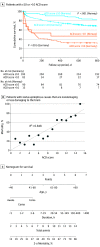Prediction of Long-term Survival After Status Epilepticus Using the ACD Score
- PMID: 35404392
- PMCID: PMC9002715
- DOI: 10.1001/jamaneurol.2022.0609
Prediction of Long-term Survival After Status Epilepticus Using the ACD Score
Erratum in
-
Error in Figure 2.JAMA Neurol. 2022 Jun 1;79(6):634. doi: 10.1001/jamaneurol.2022.1401. JAMA Neurol. 2022. PMID: 35695888 Free PMC article. No abstract available.
Abstract
Importance: Early prediction of long-term mortality in status epilepticus is important given the high fatality rate in the years after diagnosis.
Objective: To improve prognostication of long-term mortality after status epilepticus diagnosis.
Design, settings, and participants: This retrospective, multicenter, multinational cohort study analyzed adult patients who were diagnosed with and treated for status epilepticus at university hospitals in Odense, Denmark, between January 1, 2008, and December 31, 2017, as well as in Oslo, Norway; Marburg, Germany; and Frankfurt, Germany. They were aged 18 years or older and had first-time, nonanoxic status epilepticus. A new scoring system, called the ACD score, for predicting 2-year (long-term) mortality after hospital discharge for status epilepticus was developed in the Danish cohort and validated in the German and Norwegian cohorts. The ACD score represents age at onset, level of consciousness at admission, and duration of status epilepticus. Data analysis was performed between September 1, 2019, and March 31, 2020.
Exposures: Long-term follow-up using data from national and local civil registries in Denmark, Norway, and Germany.
Main outcomes and measures: The predefined end point was 2-year survival for all patients and for a subgroup of patients with status epilepticus causes that were not damaging or were less damaging to the brain. Neurological deficits before and after onset, demographic characteristics, etiological categories of status epilepticus, comorbidities, survival, time points, treatments, and prognostic scores for different measures were assessed.
Results: A total of 261 patients (mean [SD] age, 67.2 [14.8] years; 132 women [50.6%]) were included, of whom 145 patients (mean [SD] age, 66.3 [15.0] years; 78 women [53.8%]) had status epilepticus causes that were not damaging or were less damaging to the brain. The validation cohort comprised patients from Norway (n = 139) and Germany (n = 906). At hospital discharge, 29.8% of patients (n = 64 of 215) had new moderate to severe neurological deficits compared with baseline. New neurological deficits were a major predictor of 2-year survival after hospital discharge (odds ratio, 5.1; 95% CI, 2.2-11.8); this association was independent of etiological category. Nonconvulsive status epilepticus in coma and duration of status epilepticus were associated with development of new neurological deficits, and a simple 3-factor score (ACD score) combining these 2 risk factors with age at onset was developed to estimate survival after status epilepticus diagnosis. The ACD score had a linear correlation with 2-year survival (Pearson r2 = 0.848), especially in the subset of patients with a low likelihood of brain damage.
Conclusions and relevance: This study found that age, long duration, and nonconvulsive type of status epilepticus in coma were associated with the development of new neurological deficits, which were predictors of long-term mortality. Accounting for risk factors for new neurological deficits using the ACD score is a reliable method of prediction of long-term outcome in patients with status epilepticus causes that were not damaging or were less damaging to the brain.
Conflict of interest statement
Figures


Comment in
-
Surviving the Storm-Surviving Status Epilepticus.Epilepsy Curr. 2022 Sep 23;22(6):359-361. doi: 10.1177/15357597221122648. eCollection 2022 Nov-Dec. Epilepsy Curr. 2022. PMID: 36426189 Free PMC article. No abstract available.
References
Publication types
MeSH terms
LinkOut - more resources
Full Text Sources
Medical

